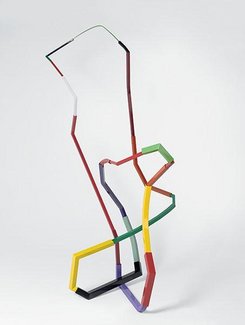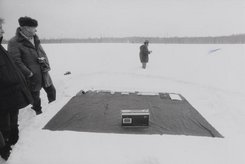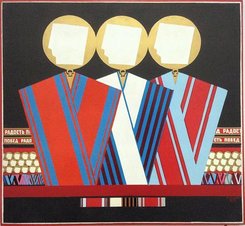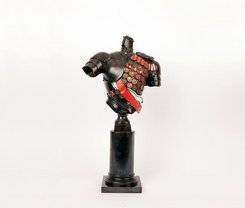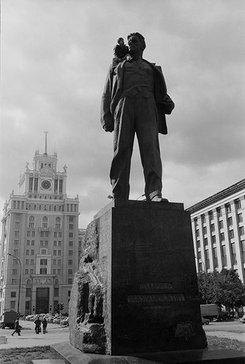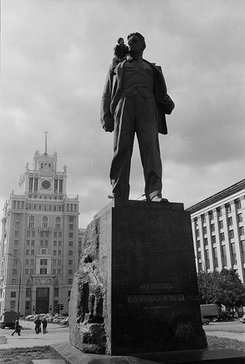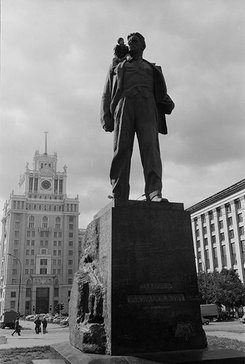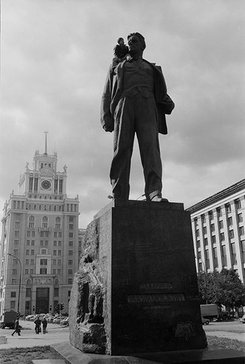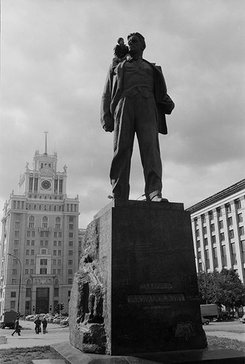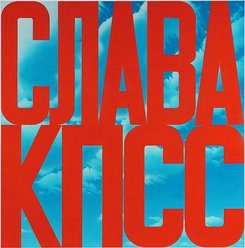Exhibition
Kollektsia ! Contemporary Art in the USSR and Russia. 1950-2000
A major donation
14 Sep 2016 - �2 Apr 2017
14 Sep 2016 - �2 Apr 2017

The event is over

On 14 September 2016, the Centre Pompidou will unveil an extraordinary donation of more than 250 works of Soviet and Russian contemporary art assembled through the outstanding efforts of the Vladimir Potanin Foundation, and presented to the Musée National d’Art Moderne thanks to the generosity of the Foundation and the collectors, artists and their families. Taking place in 2016 among a series of events paying tribute to the role of donors, the exhibition highlights once again their crucial importance to the development of cultural heritage institutions. Without pretending to the exhaustive, this ensemble of works by major artists offers a panorama of some forty years of contemporary art in the USSR and then in Russia, covering the most important movements.
The exhibition will reveal the wealth and diversity of an art created outside official structures. In the late 1950s, stimulated by the exhibitions of art from abroad made possible by Khrushchev’s thaw, non-conformist artists like Francisco Infante, Vladimir Yakovlev and Yuri Zlotnikov re-engaged with the aesthetic practices of the Russian modernist avant-gardes, source of inspiration for so many Western artists, and sought to invent their own formal language. In 1962, Khrushchev’s closure of the non-conformist room at the famous Moscow Manege exhibition signalled the exclusion from official exhibition spaces, for many years again, of any art that departed from the official doctrine of Socialist Realism, whose adoption in the 1930s had brought an end to Modernist experiment in the USSR. The 1970s then saw the emergence of two major movements, their boundaries somewhat loosely defined. Moscow Conceptualism achieved a certain ascendancy with the work of Ilya Kabakov, Viktor Pivovarov and Rimma and Valery Gerlovin, then followed by Andrei Monastyrsky and Dmitri Prigov. According a leading role to language and working at the intersection of poetry, performance and visual art, these artists proposed, in the Moscow of the Brezhnevite stagnation, a conceptual art that reflected the primacy of literature in Russian culture.
The first Conceptualists were joined in the late 1970s by a second generation that included the Mukhomor group, Yuri Albert, Mikhail Roshal, Viktor Skersis and Vadim Zakharov. Alongside Moscow Conceptualism, the Sots Art invented by Komar and Melamid played in Pop fashion on the codes of Soviet propaganda. Unlike the Pop artists – confronted by a superabundance of consumer goods – Alexander Kosolapov, Boris Orlov and Leonid Sokov sought to demythologise the ideological environment of Soviet society. A prolifically productive movement, a number of whose representatives would emigrate from the 1970s onward, Sots Art strongly influenced the aesthetics of the perestroika years, inspiring the work of numerous artists, among them Grisha Bruskin.
The advent of perestroika in the mid-1980s was marked by a real creative effervescence imbued by the underground culture sustained by a number of squats. An intoxicating sense of freedom informed the work of the young artists of the day: Sergei Anufriev, Andrei Filippov, Yuri Leiderman, Pavel Pepperstein and the Pertsy group (“The Peppers”) in Moscow and Sergei Bugaev-Afrika, Oleg Kotelnikov, Vladislav Mamyshev-Monroe and Timur Novikov in Leningrad. The end of the decade saw the legitimation of this art born on the margins. The mechanisms of a hitherto non-existent art market began to be set in place: in 1988, a first auction organised by Sotheby’s in Moscow gave a tangible value to unofficial art, and the boundary between official and unofficial abruptly disappeared. A new generation of artists appeared, among them AES+F, Dmitri Gutov, Valery Koshlyakov and Oleg Kulik. The 2000s saw contemporary art institutionalised and become an integral part of the national culture.
Actions collectives, AES+F (Tatiana Arzamasova, Lev Evzovich, Evgeny Svyatsky, Vladimir Fridkes), Yuri Albert, Sergei Anufriev, Yuri Avvakumov, Erik Bulatov, Grisha Bruskin, Sergei Bugaev-Afrika, Champions du monde, Ivan Chuikov, Mikhail Roshal-Fedorov, Andrei Filippov, Rimma and Valery Gerlovin, Georgy Gurianov, Dmitri Gutov, Andrei Iakhnin, Francisco Infante-Arana, Inspection « Herméneutique Médicale », Ilya et Emilia Kabakov, George Kiesewalter, Vitaly Komar & Alexander Melamid, Valery Koshlyakov, Alexander Kosolapov, Oleg Kotelnikov, Nikolai Kozlov, Oleg Kulik, Yuri Leiderman, Igor Makarevich et Elena Elaguina, Vladislav Mamyshev-Monroe, Boris Mikhailov, Sergei Mironenko, Vladimir Mironenko, Andrei Monastyrsky, Mukhomor, Vladimir Nemukhin, Timur Novikov, Boris Orlov, Pertsy, Pavel Pepperstein, Viktor Pivovarov, Alexandre Ponomarev, Dmitri Prigov, Oskar Rabin, Mikhail Roginsky, Andrei Roiter, Sergei Serp, Igor Shelkovski, Viktor Skersis, Leonid Sokov, Eduard Steinberg, SZ, Boris Turetsky, Sergei Volkov, Vladimir Yakovlev, Vladimir Yankilevsky, Evgeny Yufit, Vadim Zakharov, Yuri Zlotnikov, Konstantin Zvezdochetov, Larisa Zvezdochetova-Rezun.

Interview with Oksana Oracheva, general director of Vladimir Potanin Foundation
What is the mission of the Vladimir Potanin Foundation?
Oksana Oracheva – Established by the businessman Vladimir Potanin, this private foundation supports the training of professionals working in art and culture, and works to promote philanthropic activity in Russia.
What is the significance of this exceptional project with the Centre Pompidou?
OO – The Foundation is thrilled to have been able to help such an outstanding museum constitute a collection of contemporary Russian art. Russian art ought to be represented in major institutions abroad so that people can gain an idea of what Russia is today. Furthermore, the acquisition of new works is essential to the vitality of any collection or museum. We did something similar in 2002, when Vladimir Potanin acquired Malevich’s Black Square on a White Ground for the Hermitage Museum, an initiative that attracted other donors and gave new impetus to the development of the Hermitage’s collections. This donation to the Centre Pompidou is also a symbolic gesture that we hope will lead to more pertinent and substantial representation of Russian art in France and elsewhere in Europe, and possibly even stimulate other donations. It’s a unique project, a true partnership, a combined effort… The artists who have offered works and the collectors who have been willing to part with some of their collections are fully committed to the crucial project of allowing the European public to form an image of Russia through an encounter with its contemporary art.
What does the Foundation hope for from this initiative?
OO – Art is a universal language understandable by all. Through this donation we hope to make contemporary Russian art better known in the West, and that the emergence of a new philanthropy will encourage the development of the practice of donation at the European level.
Oksana Oracheva
Source :
in Code Couleur, n°26, september-december 2016, pp. 32-33
Where
Musée - Niveau 4
When
14 Sep 2016 - �2 Apr 2017
11am - 9pm, every days except tuesdaysPartners

